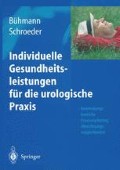Zusammenfassung
Verbesserte Lebensbedingungen und Hygiene sowie Fortschritte in der Prävention und Behandlung von Krankheiten haben die Lebenserwartung der Menschen deutlich steigen lassen. Akute Erkrankungen sind nicht länger Haupttodesursache, vielmehr sterben die Menschen heute an chronischen Erkrankungen, degenerativen Erkrankungen und Tumoren. Hiermit ist eine verlängerte Immobilität und Pflegebedürftigkeit verbunden, die die letzten Lebensjahre für viele Menschen oft beschwerlich macht und ihre Betreuung zu einem erheblichen Kostenfaktor werden lässt.
Access this chapter
Tax calculation will be finalised at checkout
Purchases are for personal use only
Preview
Unable to display preview. Download preview PDF.
Literatur
Allolio B (1999) DHEA und DHEAS. Vortrag, 2nd International Workshop on the Aging Male: New Research Needs. 6.-8. November 1999, Weimar
Arlt W, Beuschlein F, Allolio B (1999) Adrenal cortex insufficiency: diagnosis and therapy. Med Klin 94/6: 353–354
Arlt W, Haas J, Callies F et al. (1999) Biotransformation of oral dehydroepiandrosterone in elderly men: significant increase in circulating estrogens. J Clin Endocrinol Metab 84/6: 2170–2176
Arlt W, Callies F, van Vlijmen JC et al. (1999) Dehydroepiandrosterone replacement in women with adrenal insufficiency. N Engl J Med 30, 341/14: 1013–1020
Arvat E, Ceda G, Ramunni J et al. (1998) The IGF-I response to very low rhGH doses is preserved in human age. Clin Endocrinol 49/6: 757–763
Baulieu E-E (1996) Dehydroepiandrosterone (DHEA): a fountain of youth? J Clin Endocrinol Metab 81: 3147–3151
Bengtsson B (1999) Growth hormone and its secretagogues. Vortrag: 2nd International Workshop on the Aging Male: New Research Needs. 6.-8. November 1999, Weimar
Berr C, Lafont S, Debuire N et al. (1996) Relationships of dehydroepiandrosterone sulfate in the elderly with functional,psychological, and mental status, an short-term mortality: a French community-based study. Proc Natl Acad Sci USA 93: 13410–13415
Endoh A, Kristiansen SB, Casson PR et al. (1996) The zona reticularis is the site of biosynthesis of dehydroepiandrosterone and dehydroepiandrosterone sulfate in the adult human adrenal cortex resulting from its low expression of 3 beta-hydroxysteroid dehydrogenase. J Clin Endocrinol Metab 81/10: 3558–3565
Feldmann HA, Goldstein I, Hatzichristou DG et al. (1994) Impotence and its medical and psychosocial correlates: Results of the Massachusetts Male Aging Study. J Urol 151: 54–61
Feldmeier H, Nass R, Strasburger CJ (1996) Wachstumshormonsubstitution im Erwachsenenalter. Fortschr Med 114/16: 205–208
Flynn MA, Weaver-Osterholtz KL, Sharpe-Timms SA et al. (1999) Dehydroepiandrosterone replacement in aging humans. J Clin Endocrinol Metab 84: 1527–1533
Garfinkel D, Laudon M, Nof D et al. (1995) Improvement of sleep quality in elderly people by controlled-release melatonin. Lancet 346: 541–544
Hess RA, Bunick D, Lee K-H et al. (1997) A role for oestrogens in the male reproductive system. Nature 390: 509–512
Kimonides VG, Khatibi NH, Svendsen CN et al. (1998) Dehydroepiandrosterone (DHEA) and DHEA-sulfate (DHEAS) protect hippocampal neurons against excitatory amino acid-induced neurotoxicity. Proc Natl Acad Sci USA 95: 1852–1857
Labrie F, Belanger A, Cusan L et al. (1997) Physiological changes in dehydroepiandrosterone are not reflected by serum levels of active androgens and estrogens but of their metabolites: intracrinology. J Clin Endocrinol Metab 82/8: 2403–2409
Ladriere L, Laghmich A, Malaisse LF et al. (1997) Effect of dehydroepiandrosterone in hereditarily diabetic rats. Cell Biochem Funct 15/4: 287–292
Melvin WS, Boros LG, Muscarella P et al. (1997) Dehydroepiandrosterone-sulfate inhibits pancreatic carcinoma cell proliferation in vitro an in vivo. Surgery 121: 392–397
Oettel M (1998) The therapeutic potential for non feminizing estrogens in men. The Aging Male 1/5 [Suppl 1]: 008
Porst H (2000) Manual der Impotenz. UNI-MED, 5 393–396
Reiter WJ, Pycha A, Lodde M et al. (1998) Dehydroepiandrosterone in the treatment of erectile dysfunction: a prospective, double-blind randomized, placebo-controlled study. Int J Impotence Res 10 [Suppl 3]: 39
Van den Beld AW, Grobbee DE, Pols HAP et al. (1998) The role of estrogens in physical and psychological wellbeing elderly men. The Aging Male 1 [Suppl 1]: 54
Wang C (1999) Estrogens and elderly men. Vortrag: 2nd International Workshop on the Aging Male: New Research Needs. 6.-8. November 1999, Weimar
Wolkowitz OM, Reus VI, Keebler BA et al. (1999) Doubleblind treatment of major depression with dehydroepiandrosterone. Am J Psychiatry 156: 646–649
Editor information
Editors and Affiliations
Rights and permissions
Copyright information
© 2004 Springer-Verlag Berlin Heidelberg
About this chapter
Cite this chapter
Heina, I. (2004). Wechseljahre des Mannes und Hormonsubstitution. In: Bühmann, W., Schroeder, A. (eds) Individuelle Gesundheitsleistungen für die urologische Praxis. Springer, Berlin, Heidelberg. https://doi.org/10.1007/978-3-642-59292-8_5
Download citation
DOI: https://doi.org/10.1007/978-3-642-59292-8_5
Publisher Name: Springer, Berlin, Heidelberg
Print ISBN: 978-3-540-14006-1
Online ISBN: 978-3-642-59292-8
eBook Packages: Springer Book Archive

